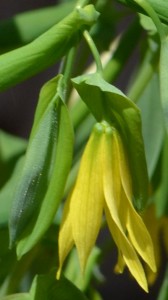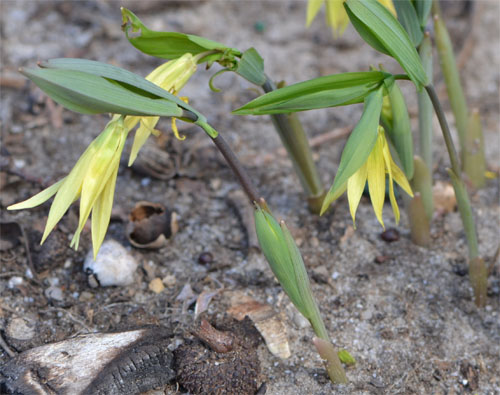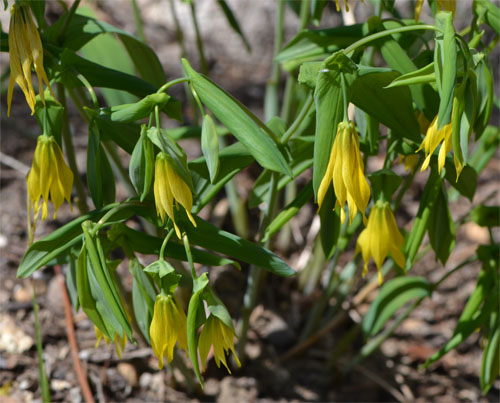 When I planted large bellwort (Uvularia grandiflora) last year, I had no idea what I was in for. I had acquired the plants, flowerless and sorry looking, at a discount at Mahoney’s and unlike Dickens I had no great expectations. It is now the middle of April and the plants have pushed through the soil in record speed. They had barely surfaced when the flowers emerged. I love everything about this plant, from the light bluish-green leaves to the jewel like golden-white flowers. The singular plants from last year have emerged as clumps, and I am anticipating / hoping that they will spread among the christmas ferns and ostrich ferns already present. The area I selected has always given me problems – it’s fairly sunny until the oaks above produce their leaves, and from then on it turns into a mottled sunlight and full shade area over the course of the day. The land has a gentle slope to it; just enough to have the occasional heavy downpour wash away the top soil and the seedlings within. The Uvularia grandiflora may remedy this as the rootstock and plant stems are holding the soil in place better than any other plant I have tried – at least so far – we haven’t seen rain in over a month – the real test will be later this weekend when heavy downpours are expected. I’ve read that large bellwort can easily be propagated by dividing the clumps and by taking cuttings from the root stock. It may also propagate from seed, although that seems to be much less reliable.
When I planted large bellwort (Uvularia grandiflora) last year, I had no idea what I was in for. I had acquired the plants, flowerless and sorry looking, at a discount at Mahoney’s and unlike Dickens I had no great expectations. It is now the middle of April and the plants have pushed through the soil in record speed. They had barely surfaced when the flowers emerged. I love everything about this plant, from the light bluish-green leaves to the jewel like golden-white flowers. The singular plants from last year have emerged as clumps, and I am anticipating / hoping that they will spread among the christmas ferns and ostrich ferns already present. The area I selected has always given me problems – it’s fairly sunny until the oaks above produce their leaves, and from then on it turns into a mottled sunlight and full shade area over the course of the day. The land has a gentle slope to it; just enough to have the occasional heavy downpour wash away the top soil and the seedlings within. The Uvularia grandiflora may remedy this as the rootstock and plant stems are holding the soil in place better than any other plant I have tried – at least so far – we haven’t seen rain in over a month – the real test will be later this weekend when heavy downpours are expected. I’ve read that large bellwort can easily be propagated by dividing the clumps and by taking cuttings from the root stock. It may also propagate from seed, although that seems to be much less reliable.

Large bellwort on April 15 2012
The plants I have are about 10 inches tall, but they can grow to 20 inches. While you can still find people who use large bellwort leaves, roots and flowers in the kitchen, in salads, vegetable dishes, soups, and as pickles or fritters. However, large scale use dates back to the early settlers. In those days the plant was also used as a general stomach remedy, a poultice for wounds and skin inflammations. A concoction from the roots was used for canker sores.

The same large bellwort one week later, on April 21 2012
If you are looking for an eye catching spring accent plant that can double as ground cover, take a look at large bellwort.
Leave a Reply